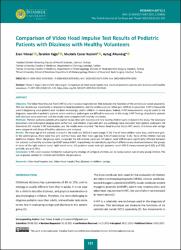| dc.contributor.author | Yılmaz, Eren | |
| dc.contributor.author | Yağcı, İbrahim | |
| dc.contributor.author | Kesimli, Mustafa Caner | |
| dc.contributor.author | Altundağ, Aytuğ | |
| dc.date.accessioned | 2023-12-28T15:01:19Z | |
| dc.date.available | 2023-12-28T15:01:19Z | |
| dc.date.issued | 2022 | en_US |
| dc.identifier.issn | 2602-4837 | |
| dc.identifier.uri | https://hdl.handle.net/11363/6818 | |
| dc.description.abstract | Objective: The Video Head Impulse Test (V-HIT) is a non-invasive diagnostic test that evaluates the functions of the semicircular canals separately.
This test records eye movements in response to head movements, and the vestibulo-ocular reflex gain (VOR-G) is calculated. V-HIT is frequently
used in diagnosing adult patients and has been increasingly used in children in recent years. Indeed, V-HIT measurements may be useful in the
diagnosis, especially in pediatric patients where vestibular pathologies are difficult to evaluate. In this study, V-HIT findings of pediatric patients
with dizziness were examined, and the results were compared with healthy volunteers.
Methods: Thirteen pediatric patients who applied to our clinic with dizziness and nine healthy children were included in the study. The necessary
evaluations and radiological imaging were performed, and children diagnosed with any pathology were excluded. Each patient underwent GN
Otometrics ICS Impulse V-HIT examination, and the results were recorded. The Video Head Impulse Test (v-HIT) results of children with vertigo
were compared with those of healthy volunteers and analyzed.
Results: The mean age of the patients included in the study was 10.5±3.5 years (range: 5-16). Five of these children were boys, and 8 were girls.
In the control group, there were five girls and four boys, and their mean age was 9.3±3.9 years (range: 5-16). None of the children had any
additional disease. When the groups were compared, the left anterior canal and left lateral canal VOR-Gs were significantly different between
the patients and healthy volunteers (p=0.027 and p=0.007, respectively). No statistically significant difference was observed between the groups
in terms of the right anterior canal, right lateral canal, left posterior canal, and right posterior canal VOR-G measurements (p=0.928, p=0.738,
p=0.588, and p=0.780,).
Conclusion: V-HIT, a non-invasive method for evaluating the etiology of vertigo in children, can be easily applied even in very young children. The
use of glasses suitable for children will facilitate the procedure. | en_US |
| dc.language.iso | eng | en_US |
| dc.publisher | İstanbul Üniversitesi | en_US |
| dc.relation.isversionof | https://doi.org/10.26650/Tr-ENT.2022.1159646 | en_US |
| dc.rights | info:eu-repo/semantics/openAccess | en_US |
| dc.subject | Video head impulse test | en_US |
| dc.subject | Video Head Impulse Test | en_US |
| dc.subject | Dizziness in children | en_US |
| dc.subject | Vertigo | en_US |
| dc.title | Comparison of Video Head Impulse Test Results of Pediatric Patients with Dizziness with Healthy Volunteers | en_US |
| dc.type | article | en_US |
| dc.relation.ispartof | The Turkish Journal of Ear Nose and Throat | en_US |
| dc.department | Sağlık Bilimleri Fakültesi | en_US |
| dc.authorid | https://orcid.org/0000-0002-5349-9699 | en_US |
| dc.authorid | https://orcid.org/0000-0003-2039-8362 | en_US |
| dc.authorid | https://orcid.org/0000-0003-1675-0394 | en_US |
| dc.authorid | https://orcid.org/0000-0003-0794-5050 | en_US |
| dc.identifier.volume | 32 | en_US |
| dc.identifier.issue | 4 | en_US |
| dc.identifier.startpage | 121 | en_US |
| dc.identifier.endpage | 125 | en_US |
| dc.relation.publicationcategory | Makale - Ulusal Hakemli Dergi - Kurum Öğretim Elemanı | en_US |
| dc.contributor.institutionauthor | Yılmaz, Eren | |

















